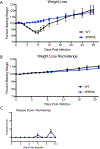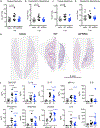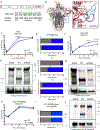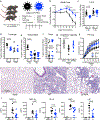Loss of furin cleavage site attenuates SARS-CoV-2 pathogenesis
- PMID: 33494095
- PMCID: PMC8175039
- DOI: 10.1038/s41586-021-03237-4
Loss of furin cleavage site attenuates SARS-CoV-2 pathogenesis
Abstract
Severe acute respiratory syndrome coronavirus 2 (SARS-CoV-2)-a new coronavirus that has led to a worldwide pandemic1-has a furin cleavage site (PRRAR) in its spike protein that is absent in other group-2B coronaviruses2. To explore whether the furin cleavage site contributes to infection and pathogenesis in this virus, we generated a mutant SARS-CoV-2 that lacks the furin cleavage site (ΔPRRA). Here we report that replicates of ΔPRRA SARS-CoV-2 had faster kinetics, improved fitness in Vero E6 cells and reduced spike protein processing, as compared to parental SARS-CoV-2. However, the ΔPRRA mutant had reduced replication in a human respiratory cell line and was attenuated in both hamster and K18-hACE2 transgenic mouse models of SARS-CoV-2 pathogenesis. Despite reduced disease, the ΔPRRA mutant conferred protection against rechallenge with the parental SARS-CoV-2. Importantly, the neutralization values of sera from patients with coronavirus disease 2019 (COVID-19) and monoclonal antibodies against the receptor-binding domain of SARS-CoV-2 were lower against the ΔPRRA mutant than against parental SARS-CoV-2, probably owing to an increased ratio of particles to plaque-forming units in infections with the former. Together, our results demonstrate a critical role for the furin cleavage site in infection with SARS-CoV-2 and highlight the importance of this site for evaluating the neutralization activities of antibodies.
Conflict of interest statement
Competing interests
XX, P-YS, and VDM have filed a patent on the reverse genetic system and reporter SARS-CoV-2. Other authors declare no competing interests. M.S.D. is a consultant for Inbios, Vir Biotechnology, NGM Biopharmaceuticals, and on the Scientific Advisory Board of Moderna and Immunome. The Diamond laboratory has received unrelated funding support in sponsored research agreements from Moderna, Vir Biotechnology, and Emergent BioSolutions.
Figures









Update of
-
Furin Cleavage Site Is Key to SARS-CoV-2 Pathogenesis.bioRxiv [Preprint]. 2020 Aug 26:2020.08.26.268854. doi: 10.1101/2020.08.26.268854. bioRxiv. 2020. Update in: Nature. 2021 Mar;591(7849):293-299. doi: 10.1038/s41586-021-03237-4. PMID: 32869021 Free PMC article. Updated. Preprint.
References
Methods References
Publication types
MeSH terms
Substances
Grants and funding
- R01 AI134907/AI/NIAID NIH HHS/United States
- R01 AI157155/AI/NIAID NIH HHS/United States
- R00 AG049092/AG/NIA NIH HHS/United States
- R01 AI153602/AI/NIAID NIH HHS/United States
- R43 AI145617/AI/NIAID NIH HHS/United States
- UL1 TR001439/TR/NCATS NIH HHS/United States
- R01 AI123449/AI/NIAID NIH HHS/United States
- R21 AI145400/AI/NIAID NIH HHS/United States
- T32 AI007163/AI/NIAID NIH HHS/United States
- T32 AI007526/AI/NIAID NIH HHS/United States
- U19 AI142759/AI/NIAID NIH HHS/United States
- R24 AI120942/AI/NIAID NIH HHS/United States
- F30 AI152327/AI/NIAID NIH HHS/United States
LinkOut - more resources
Full Text Sources
Other Literature Sources
Medical
Molecular Biology Databases
Miscellaneous

